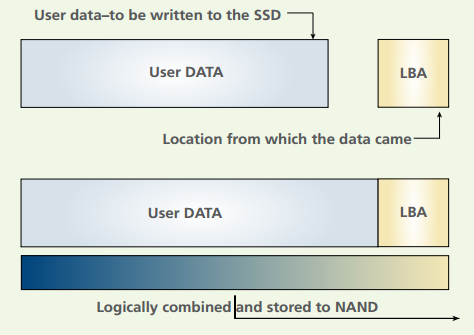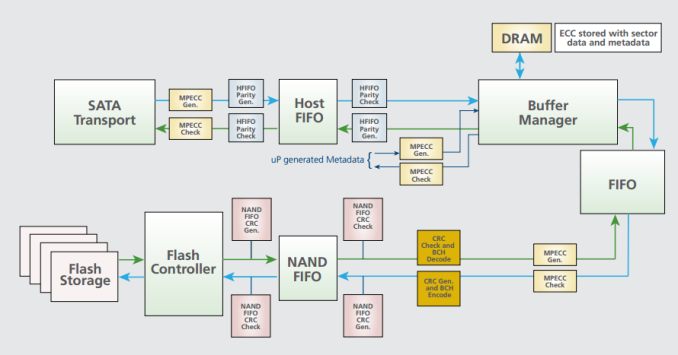Micron M500DC (480GB & 800GB) Review
by Kristian Vättö on April 22, 2014 2:35 PM ESTThe Features
Micron calls its enterprise feature set eXtended Performance and Enchanced Reliability Technology or just XPERT. It's a combination of hardware and software-level features that help to extend endurance and ensure data integrity at any time. Some elements of XPERT are present in client drives as well while some are limited to Micron's enterprise SSDs.
ARM/OR
ARM/OR, short for Advanced Read Management/Optimized Read, is Micron's adaptive DSP technology (i.e. aDSP). The idea behind ARM/OR and aDSP in general is to monitor the NAND voltages in real time and make changes if necessary.
As NAND wears out, electrons get trapped inside the silicon oxide and floating gate. This changes the voltage required to read/program the cell (as the graph above shows) and eventually the cell would reach a point where it cannot be read/programmed using the original voltage. With ARM/OR the controller can adapt to the changes in read/program voltages and can continue to operate even after significant wear.
RAIN
We've talked about RAIN (Redundant Array of Independent NAND) before as it is a feature Micron utilizes in all of its SSDs but I'll go through it briefly here. Essentially RAIN is a RAID 5 like structure that uses parity to protect against data loss. In the case of the M500DC, the stripe ratio is 11:1 for the 120GB, 240GB and 480GB models and 15:1 for the 800GB one, meaning that one page/block is reserved for parity for every 11 or 15 pages/blocks. The parity can then be used to recover data in case there is a block failure or the data gets corrupted.
DataSAFE
DataSAFE ensures that all data, read or written, is intact. When writing data, Micron not only writes the data from the host to the NAND but also the metadata associated with the data (i.e. its logical block address/LBA). When the host then requests the data to be read from the drive, the LBA of the data is first compared against the value in the L2P table (logical to physical -- Micron's name for the NAND mapping table) before sending the data to the host. This ensures that the data that is being read from the NAND is in fact the same data that the host requested. If the LBA values of the NAND and L2P table are different, then the drive will have to rely on ECC or RAIN to recover the correct data.
In addition to LBA embedding and read checking, DataSAFE does data path protection from the SATA transport all the way to the NAND controller. While client drives only generate CRC and BCH error correction codes to detect errors, the enterprise drives add an additional memory correction ECC (MPECC) layer. MPECC is a 12-byte error-correcting code that follows the user data during its whole path. The difference between the client and enterprise solutions is that the client drives rely on the host to make the actual error correcting, whereas the MPECC layer can correct a single-bit error within the data path (i.e. before the data even hits the host).
Power Loss Protection
While both Micron's client and enterprise SSDs feature power loss protection, there is a difference between them. The enterprise drives features more rigid tantalum capacitors that provide a higher capacitance compared to the standard capacitors used in the client drives. The higher capacitance ensures that absolutely no data is lost during a power loss, whereas there is still a small risk of data loss in client drives. I believe the difference is that the capacitors in client drives only provide enough capacitance to flush the NAND mapping table (or L2P table as Micron calls it) to the NAND, while the enterprise solution guarantees that in addition to the NAND mapping table, all write requests in process will also be completed.













37 Comments
View All Comments
Solid State Brain - Tuesday, April 22, 2014 - link
Enterprise SSDs usually have their endurance rated at 3 months of residual data retention capability, vs 1 year for consumer models. Since data retention time decreases with NAND wear, this allows manufacturers to claim almost "for free" a higher endurance than what the P/E limit for consumer NAND memory would suggest, even though it might be the exact same memory (but different requirements).Most likely, the rated endurance for these drives is at a much higher number of P/E cycles than 3000.
Kristian Vättö - Tuesday, April 22, 2014 - link
"Most likely, the rated endurance for these drives is at a much higher number of P/E cycles than 3000."I don't think that is necessarily the case. If you look at my calculations on the "Endurance Ratings" page, the combined WLF and WAF is already only 1.24x when using the raw NAND capacity to calculate the endurance at 3,000 P/E cycles. 1.24x is excellent, so I find it hard to believe that the NAND would be rated at higher than 3,000 cycles as the combined WLF and WAF would essentially be about 1.00 in that case (which is basically impossible without compression). Also, Micron specifically said that this is a 3,000 P/E cycle part.
Solid State Brain - Tuesday, April 22, 2014 - link
As the endurance rating for enterprise drives is usually intended for a typical steady random workload (and no trim to help), the write amplification factor should be higher than the rather low value you used for your calculation. You can see that endurance figures (not just in this case, but most other other enterprise drives as well) start make more sense when actual P/E cycles for that usage/application are higher than their consumer counterparts.Here's a prominent example. You could try the same calculation here. In this specification sheet for 2013 Samsung enterprise drives, which includes a model with TLC NAND, it's dead obvious that the rated P/E cycles limit of consumer drives (unofficially, rated 1000 cycles) doesn't apply for them, even though for the low end models they're most certainly using the same memory. You never really see a fixed P/E cycles limit for enterprise drives as in the end is the TBW figure that counts and the shorter data retention requirement for them helps boosting that even though there might actually not be any hardware difference at all.
http://www.samsung.com/global/business/semiconduct...
apudapus - Tuesday, April 22, 2014 - link
The specs you linked definitely show 1000 P/E cycles for all the NAND on all the drives, TLC and MLC. I used this formula: Total Bytes Written Allowed = NAND P/E cycles * Total Bytes Written per DayEnterprise drives have lower data retention requirements because in the enterprise space, drives will be read and written to more frequently and will not be powered off for extended periods of time. Consumer drives on the other hand can have a lots of down time.
Solid State Brain - Tuesday, April 22, 2014 - link
PM843, TLC NAND rated 1000 P/E cycles on the consumer version. Let's take the 120GB model as an example.Endurance with 100% sequential workloads: 207 TB
1000 P/E (NAND life @ 1 year of data retention, on the consumer version) * 128 GiB (physical NAND capacity) = 128000 GB = 125 TiB. This drive doesn't make use of data compression. With sequential workloads the best case write amplification would therefore be 1.0x. To reach the claimed 207 TiB of terabytes written of endurance, the NAND memory on this drive would need at the very least to endure 1000/125*207 = 1656 P/E cycles, again assuming the best case write amplification factor. One can expect this to be at least around 1.15-1.20x under real world scenarios, which would bring this figure to about 1900-2000 P/E cycles.
SM843, the enterprise version of the 840 Pro with 3000 P/E cycles MLC NAND. Again, let's take the 120GB version for reference.
Stated endurance with 100% sequential workloads: 1 PB
128 GiB physical capacity * 3000 P/E cycles = 375 TiB
Actual P/E cycles needed for 1 PB at 1.0x write amplification: 3000 * 1024/375 = 8192
Kristian Vättö - Wednesday, April 23, 2014 - link
Like I said, ultimately it's impossible to figure out where exactly the endurance is coming from. It's likely that the NAND could be rated higher thanks to the looser retention requirements (3 months vs 1 year) in the enterprise space but then again, figuring out the exact P/E cycle count isn't easy because we don't know the write amplification.Solid State Brain - Wednesday, April 23, 2014 - link
If you have spare time and still have the drives you could try applying a standard sustained 4kB random load for an extended period of time to figure out what the write amplification for these drives with that usage is. Marvell-based SSDs usually provide, in a way or another, both NAND writes and Host writes among their monitoring attributes, and with these data it's pretty straightforward to calculate it. Given the large OP area, I predict it will end up being somewhere around 2.5x.Kristian Vättö - Wednesday, April 23, 2014 - link
I still have the drives but there are other products in the review queue. I'll see what I can do -- the process is rather simple as you outlined I've done some similar testing in the past too.Kristian Vättö - Wednesday, April 23, 2014 - link
*and I've done similar testing in the past too.(Yes, we need an edit button)
apudapus - Wednesday, April 23, 2014 - link
OIC. My best guess is that the voltage thresholding (their ARM/OR) extends the life of the NAND.